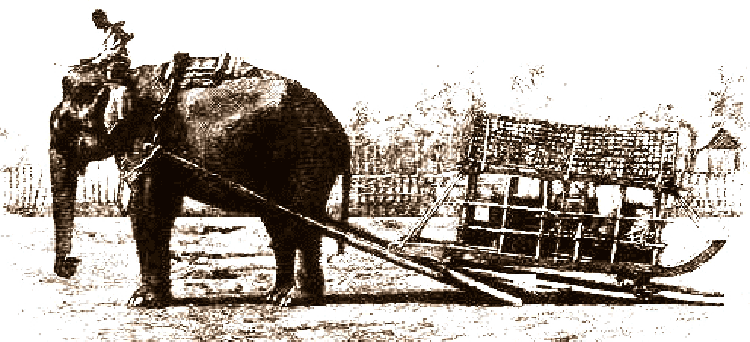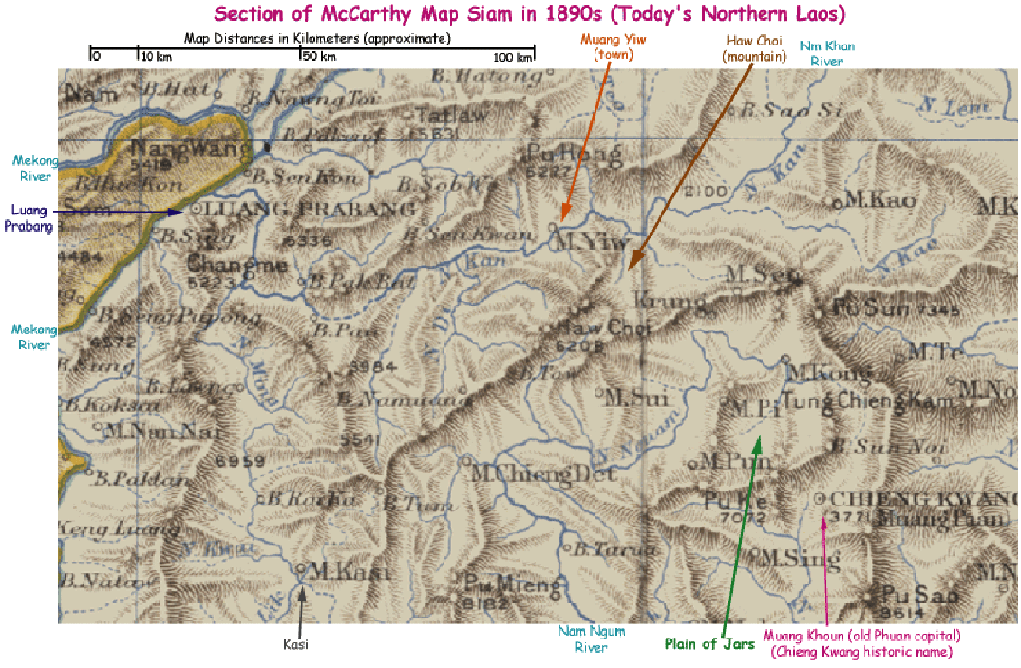
James McCarthy Exploration of Plain of Jars in Northern Laos - by HoboMaps.com - Go to Plain of Jars Info Page - - - Home
This webpage contains information from James McCarthy's publication "Surveying and Exploring in Siam (1900)" which includes his travels in the Plain of Jars (PDJ) area of Northern Laos in the 1880s to 1890s and descriptions of the megalithic stone jars he found there. McCarthy was conducting a triangulation survey of the area in connection with the preparation of the first map of Siam drawn to scale under the auspices of the King of Siam. At the time of his visits the area above and east of the Mekong River in modern-day Laos was partially under the control of Siam before it was ceded to France in 1893.
For sections relevant to the Plain of Jars see:
- Chapter XI "In Track of the Haw"
- Chapter XII "The Chieng Kwang Highlands". Chieng Kwang (Xieng Kuang) is called Muang Khoun today, the old Phuan capital
- Chapter XXXIV "Conclusion of the Northern Triangulation" (The Stone Jars of Haw Choi).
McCarthy's book is no longer subject to copyright restrictions and we can freely copy and quote from it. The portion of his map which is relevant to the quoted text below is presented near the bottom of this webpage for reference.
Selected portion of McCarthy's book are presented below in lavendar text color with our comments added in parentheses such as the dates of his visits and modern day names of places which had different names back then.
Drawing from McCarthy's publication below showing possible transport method for Jars:

This first section is his description of the jars he saw at the Plain of Jars (PDJ) area which includes measurements of the biggest jars and the results of excavations he conducted near the jars. His first visit was in 1884 during the time the Haw raiders (coming down from China) were terrorizing and plundering the area and the text below starts on his arrival at present day Muang Soui near Nong Tang Lake about 50 km west of Phonsavanh on Highway 7. The jars he saw may have been those at present day Jar Site 1 southwest of Phonsavanh or those in the Koon District area northwest of Phonsavanh. The quoted text starts at the middle of page 49 from CHAPTER XI IN TRACK OF THE HAW.
"Suddenly we came on a charming little lake, Nawng Tang, at an elevation of 4000 feet above sea-level. It was over a mile long and half a mile broad, and never dry. On the east side stood a lime cliff about 100 feet high. The deep blue sky reflected in the bosom of the lake, and the intense stillness, only relieved by the motions of the water-fowl, deepened the pleasurable sensations which the beauty of the surrounding landscape excited. Notwithstanding the beauty of the country, there was no sign of human life as far as the eye could reach. We met with some peafowl, rarely found at so high an elevation, and, as tigers keep company with peafowl, we were not long in finding traces of them. Partridges were plentiful, as also were deer. We passed over the sites of many battlefields, and at Kung Koi we remarked the traces of an old stockade.
We crossed the Nam Tang, a small stream running in a channel whose banks were over 100 feet deep, and about 800 yards apart. The valley was well suited for rice cultivation. On ascending the bank of the stream we met with other surprises. A vast plain, called Kung Ma Len "Ponies Play-ground", about 6 miles broad and 10 long, and about 3500 feet above sea-level, stretched as flat as a table before our view. It was covered with fine grass, and had afforded excellent pasturage for cattle, which in better days had fed there in great numbers. We rested under the shade of a pine tree, and easily distinguished the snake-like course of the pathway as it ascended the gentle slope of a hill.
On the right rose a particularly beautiful pagoda, whose glittering whiteness was intensified by contrast with the blue sky. It looked like some spirit brooding over the stillness of the lovely solitude. In the distance we beheld objects which, to our surprise, looked like tents; on nearer view the tents seemed to give place to cattle, our wish being doubtless father to the thought; the cattle, when subjected to the telescope, were transformed into rocks, apparently cropping up from the surface of the ground; and these, as we approached them, proved, to our astonishment, to be gigantic stone jars. Some of them stood erect, some were lying on their sides, some were in fragments, and all round there was evidence that the ground had been excavated. Beneath one of them we dug up the earth and found traces of charcoal, with what appeared to be an anklet of rusty iron.
The tallest jar was leaning; its sides were straight and measured, one 7 feet 6 inches, and the other 6 feet 4 inches above the ground; it was 19 feet 5 inches in girth about the middle, and was 1 foot thick. Another, better shaped and provided with a neck, was very much tilted over; it was nearly 6 feet high; its girth at the widest was 25 feet, and the diameter of the mouth 4 feet 6 inches. Embedded in the substance of some of the jars were nodules of quartz. Beside them lay several flat stones, one of which was 7 feet long, and 6 inches thick at the edge, but much thicker at the centre; while a smaller one, on being turned over, showed three prominences, 2 or 3 inches long, rising about an inch above the surface.
These vessels are such as could not possibly have been carried to their present position, but must have been made in situ, the local belief concerning them is that they were formed by angels to serve as drinking vessels."

The text below is from McCarthy's 1893 visit to the area about 15 kilometers northwest of present day Muang Soui - Nong Tang Lake. This is 9 years after his first sighting of jars in 1884 quoted above. He referred to these jars as being near Ban Sawt and Haw Choi which are places indicated on the map he prepared which is shown below. The jar site he describes at the northwest side of Haw Choi mountain is apparently not easily accessible these days as there are no major roads nearby and is in the upper reaches of the Nam Khan River watershed. The quoted text below starts at page 187 of his book from CHAPTER XXXIV CONCLUSION OF THE NORTHERN TRIANGULATION.
"Arrived at Ban Sawt, we met the transport sent by order of Prince Prachak; but, as the bullocks were slow and expensive, we managed to do without most of them. We had now to part with our Luang Prabang friends. The Kamu were all in excellent health and quite stout, never before in their lives having had so much to eat, and each was carrying a little money to his home.
On January 28 (1893) we completed the work on Haw Choi, but the haze had regularly set in, and it was vain to expect to see our long rays until rain had fallen. We could do nothing but set about fixing the positions of important places by short rays until rainfall. At the foot of Haw Choi, on the side of the road to Muang Yiw, were a number of large stone jars, neither so large nor so well finished as other groups.
In a hollow there were some larger, and those that were fractured showed large nodules of quartz embedded in them. Lying on the slope of the hill were numbers of small boulders, irregular masses from which, apparently, the material for the construction of the jars had been taken. We dug out the earth beneath one of the jars: digging seemed to have been carried on, at some time, beneath all of them, and this may account for their leaning position.
We found a jar of very inferior baked clay full of clay and amber beads. Another contained an urn of superior workmansliip and almost white. It was cracked and showed traces of having been searched before; there was a piece of iron which was possibly used by a former depredator, it looked as though it had been brought from the lamp-stand near the ruined wat of Ban Sawt.
We left Ban Sawt with eight elephants and twenty men, who carried all the things and instruments. On the crest of the hill, and by the side of the path, were large blocks of stone hewn into no particular shape. One was about 15 feet long, 2 feet deep, 2 feet broad at one end, and tapering at the other to 1 foot. There were three or four others, not so large.
The popular explanation is that they were the bed and pillows of the original inhabitants, the Kamu, at the time when the country was called Muang Kapatum. There is another collection of jars on a bare slope 4,095 feet above sea-level, which overlooks Kung Lat Sen plain. From Hua Chang another collection of jars was visible in the valley of the Nam Sen."
The quoted text immediately above here refers to Kung Lat Sen (Kung means "plain") which may be modern-day Lat Sen.
The jar site overlooking it is probably Jar Site 2.
The collection of jars in the valley of the Nam Sen is probably Jar Site 3 as the Nam Sen river flows just south of that jar site.